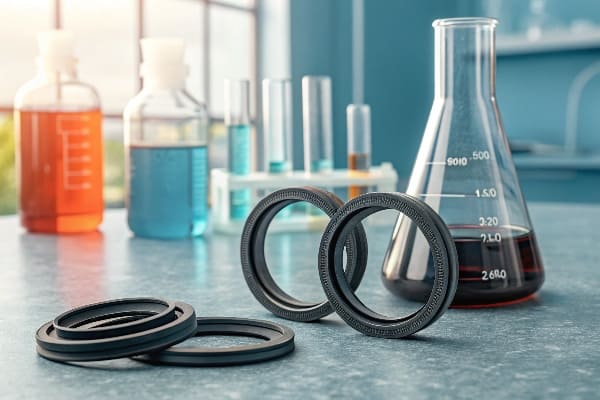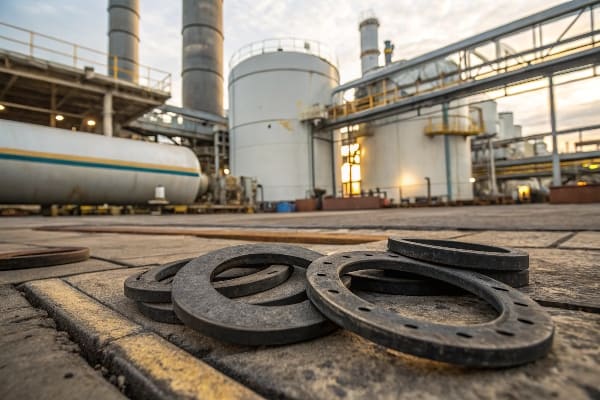Wondering if nitrile rubber (NBR) can withstand exposure to methanol? NBR is known for its resistance to oils and fuels, but how does it perform when exposed to methanol? Let's explore the compatibility of NBR with this solvent.
Nitrile rubber (NBR) shows limited compatibility with methanol. While it can resist methanol to some degree, prolonged exposure can cause it to swell, soften, and degrade.

NBR is a widely used material in industries where oil, fuel, and other chemicals are involved. However, when it comes to alcohols like methanol, it behaves differently than with petroleum-based products. Let’s take a deeper look at NBR’s performance with methanol.
What Is Nitrile Rubber (NBR)?
Before we examine how NBR reacts with methanol, let’s first understand what nitrile rubber is and why it’s commonly used in chemical resistance applications.
Nitrile rubber (NBR) is a synthetic rubber known for its excellent resistance to oils, fuels, and many petroleum-based products. However, its resistance to alcohols and solvents like methanol is more limited.
Nitrile rubber (NBR)1 is a copolymer made from acrylonitrile and butadiene. Its high content of acrylonitrile gives NBR its excellent resistance to oils, fuels, and petroleum-based chemicals, making it a popular material in industries such as automotive, aerospace, and industrial applications where contact with oils is common.
Despite its outstanding performance with petroleum-based products, NBR’s compatibility with alcohols like methanol is not as robust. NBR can withstand brief exposure to methanol2 in low concentrations but may degrade over time when exposed to high concentrations or extended contact.
The key factor that affects NBR’s performance with alcohols, including methanol, is the polarity of the solvent. Methanol is a polar solvent3, and NBR, with its non-polar characteristics, tends to absorb polar solvents, leading to swelling, softening, and eventual deterioration of the rubber.
NBR Characteristics:
- Excellent resistance to oils, greases, and fuels: Ideal for fuel hoses, O-rings, and gaskets.
- Limited performance in polar solvents: Struggles with alcohols and polar chemicals.
- Temperature resistance: Typically operates within -30°C to +100°C, depending on the grade.
| Property | NBR (Nitrile Rubber) |
|---|---|
| Chemical Resistance | Strong against oils, fuels, and petroleum-based products |
| Polar Solvent Resistance | Limited (struggles with alcohols like methanol) |
| Temperature Range | -30°C to +100°C |
| Flexibility | Good at moderate temperatures, decreases in cold conditions |
✅ Why it matters:
Understanding NBR’s basic properties is crucial when choosing it for specific applications. Its resistance to methanol and similar alcohols is an important factor in determining its suitability for certain industries.
Is NBR Compatible with Methanol?
Can NBR be safely used with methanol? Let’s explore the level of compatibility between NBR and methanol and what issues may arise in certain applications.
Nitrile rubber has limited compatibility with methanol. While NBR can handle low concentrations of methanol, prolonged exposure or high concentrations can lead to swelling, degradation, and loss of mechanical properties.

Nitrile rubber is often used in applications where resistance to oils and fuels is necessary, but its resistance to alcohols like methanol is not as strong. Methanol, being a polar solvent, interacts with the polymer structure of NBR, leading to the absorption of the solvent by the rubber. This absorption results in the rubber swelling and losing its mechanical properties.
Here’s what happens when NBR comes into contact with methanol:
- Swelling: The rubber absorbs methanol, causing it to swell. This can affect the sealing performance and fit of NBR components like O-rings and gaskets.
- Softening: Prolonged exposure to methanol can soften the rubber, reducing its elasticity and mechanical strength.
- Degradation: Over time, methanol can break down the polymer chains in NBR, leading to cracking, brittleness, and eventual failure.
For applications involving methanol or similar alcohols, specialized elastomers4, such as fluorosilicone or fluorocarbon rubber (FKM), may be more suitable due to their better resistance to alcohols and polar solvents.
| Solvent Type | NBR Compatibility | Performance Insights |
|---|---|---|
| Methanol | Limited | Causes swelling, softening, and degradation over time |
| Acetone | Poor | Causes rapid degradation and cracking |
| Petroleum-based Oils | Excellent | NBR performs optimally, ideal for oil seals, gaskets |
✅ Why it matters:
Knowing how NBR reacts with methanol helps you make informed decisions about material selection for applications involving alcohols and polar solvents.
How to Choose the Right Rubber for Methanol Exposure?
If you need to select a rubber material that can handle methanol exposure, understanding your options is key. Let’s look at the best choices for methanol-resistant rubbers.
For methanol exposure, rubbers like fluorosilicone and Viton (FKM) provide superior resistance. NBR is not ideal for extended contact with methanol due to its swelling and degradation.
When selecting rubber for methanol exposure, it's important to choose materials that can handle the solvent without breaking down. Here are some rubber materials that offer superior performance in methanol environments:
Fluorosilicone Rubber (FVMQ)5: Fluorosilicone is an elastomer known for its excellent resistance to methanol and other alcohols. It is commonly used in aerospace, automotive, and chemical processing industries where fuel and alcohol resistance is crucial. Fluorosilicone’s superior chemical resistance and temperature stability make it an ideal choice for methanol exposure.
Viton (FKM)6: Viton, or fluoroelastomer, is another excellent option for methanol resistance. Viton provides outstanding resistance to alcohols, oils, fuels, and high temperatures. It’s used in applications where high-performance sealing is needed in methanol-rich environments.
EPDM Rubber7: While not as resistant to methanol as fluorosilicone or Viton, EPDM can handle low concentrations of methanol, especially in less demanding applications. EPDM is often used for applications involving water, steam, and certain chemicals but is not the best option for high concentrations of methanol.
| Rubber Type | Methanol Resistance | Best Applications |
|---|---|---|
| Fluorosilicone | Excellent | Aerospace, automotive, fuel systems |
| Viton (FKM) | Excellent | Chemical processing, sealing applications |
| EPDM | Moderate | Low-concentration methanol exposure, water systems |
✅ Why it matters:
By selecting a more resistant rubber like fluorosilicone or Viton for methanol applications, you can ensure that your components remain reliable and durable, even in challenging chemical environments.
Conclusion
Nitrile rubber (NBR) offers limited compatibility with methanol. While it can withstand brief contact with low concentrations of methanol, prolonged exposure or high concentrations can cause NBR to swell, soften, and degrade. For applications involving methanol, consider using more resistant materials like fluorosilicone or Viton to ensure long-lasting performance.
🚀 Need Custom Rubber Solutions for Your Methanol-Resistant Applications?
Contact Julong Rubber today or Request a Custom Quote for high-quality rubber components tailored to your specifications!
Or reach out to us directly via WhatsApp:
Explore the diverse applications of Nitrile rubber (NBR) to understand its significance in automotive, aerospace, and industrial sectors. ↩
Discover the effects of methanol on Nitrile rubber to make informed decisions about material compatibility in your projects. ↩
Learn how polar solvents impact materials like Nitrile rubber, which is essential for selecting the right materials for specific applications. ↩
Discover the advantages of specialized elastomers like fluorosilicone for better performance in challenging environments. ↩
Explore the unique properties of Fluorosilicone Rubber that make it ideal for methanol applications, ensuring durability and reliability. ↩
Learn about Viton's exceptional resistance to methanol and its applications in high-performance sealing, crucial for various industries. ↩
Discover the limitations and applications of EPDM Rubber in methanol exposure, helping you make informed material choices. ↩








